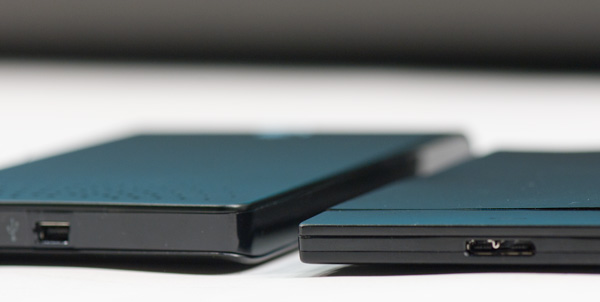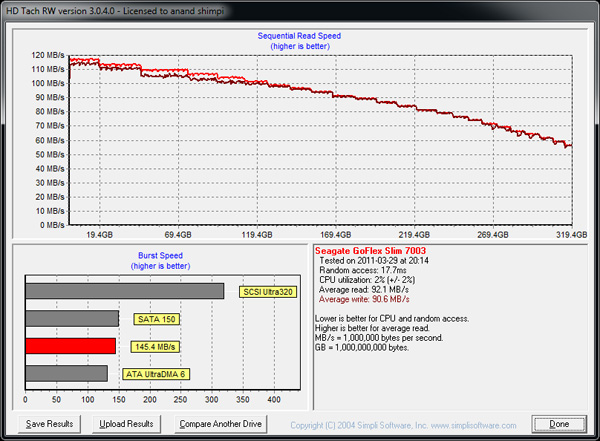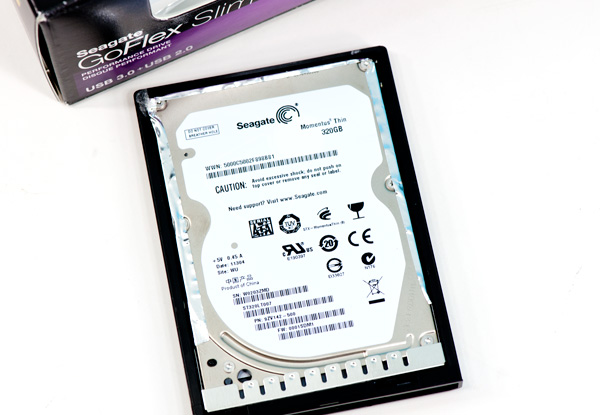Seagate GoFlex Slim 320GB: The World's Thinnest External HDD
by Anand Lal Shimpi on April 5, 2011 11:56 PM EST- Posted in
- Storage
- Seagate
- HDDs
- GoFlex
- GoFlex Slim
Performance
Most external drives are horribly limited by the performance of USB 2.0, which is why Seagate opted to outfit the GoFlex Slim with a USB 3.0 interface. If you've got a notebook with a USB 3 interface, you'll want to use it:
| Seagate GoFlex Slim Performance Comparison | ||||||
| 128KB Sequential Write | 128KB Sequential Read | 4KB Random Write (8GB LBA Space) | 4KB Random Read | |||
| Seagate GoFlex Slim 320GB USB 2.0 | 29.2 MB/s | 33.3 MB/s | 0.77 MB/s | 0.24 MB/s | ||
| Seagate GoFlex Slim 320GB USB 3.0 | 114.6 MB/s | 112.6 MB/s | 0.53 MB/s | 0.24 MB/s | ||
Over USB 2 the GoFlex slim tops out at about 33MB/s. Move over to USB 3 and you're pushing over 110MB/s at top speed. I noticed a reduction in 4KB random write performance over USB3 (likely an artifact of the NEC USB controller) but overall it's much faster.
The GoFlex Slim is obviously a platter based storage device and thus we get lower performance at higher LBAs. Over USB 2.0 you wouldn't know as we're limited by the performance of the interface:
Switch over to USB 3.0 and you'll get a familiar stair step pattern as the drive fills up the outer sectors of its single platter and moves inwards:
Final Words
Despite housing a 7200RPM 2.5" drive, the Seagate GoFlex Slim is pretty quiet thanks to its single platter design. You can tell something is spinning if you're in an absolutely quiet room, otherwise you'd be hard pressed to know you even had it plugged in.
Most 2.5" 320GB external hard drives range from $55 - $80 depending on styling and internal drive used. Given that range the GoFlex Slim definitely comes at a premium. If you've got a laptop with a USB 3.0 interface and want something extremely portable the GoFlex Slim gets the job done. Even over USB 2.0 the drive works well, it's just considerably slower. I didn't encounter any strange issues during my testing of the drive.

Seagate FreeAgent Go (left) vs. Seagate GoFlex Slim (right)

Seagate FreeAgent Go (left) vs. Seagate GoFlex Slim (right)
If you're ok paying a price premium for reducing thickness, the GoFlex Slim works. It's certainly a much nicer form factor to carry around than more traditional external 2.5" enclosures.













30 Comments
View All Comments
A5 - Wednesday, April 6, 2011 - link
I think both USB3 and eSATA are fast enough that the limiting factor for spindle drives is the drive's performance, not the interface.m00dawg - Wednesday, April 6, 2011 - link
I'm a bit confused - the drive ships with NTFS but that doesn't seem like a significant issue if we wanted to use the drive with another file-system on another OS than Windows - we just wouldn't get the backup capabilities with the Seagate software, no?I know that sounds elementary and given the internals it seems likely that formatting it to whatever I want isn't an issue like any standard drive; but the article sort of hinted at other options (such as waiting for the Mac version) and thought I would check.
ggathagan - Wednesday, April 6, 2011 - link
You are correct.It's not a significant issue.
Seagate is simply using the same marketing approach that so many others do; put out a model that's pre-formatted for the Windows users and then put out a second model in white or aluminum with HPFS formatting to cater to the Apple crowd.
It's all about "style".
Shadowmaster625 - Wednesday, April 6, 2011 - link
My experience with thinner drives is that they fail more often. There is no reason to sacrifice reliability to shave off a few mm in any situation, let alone an external drive where size doesnt matter anyway. What you gonna do with a thinner drive? Take it out to dinner more often? Put it in your pocket and carry it around? Good luck with that... I wish you and your data the best...3DoubleD - Wednesday, April 6, 2011 - link
What ever happened to the idea of combining an SSD and an HDD? I think only having an SSD in a laptop is a huge disadvantage at this time. A hybrid drive could solve this, or perhaps a pair of super thin SSD and HDDs?We need to see laptop manufacturers innovate more in this area.
How about instead of an optical drive, have a slot that can hold a hotswap external drive like this one. The drive can connect internally via USB 3.0. when you eject the drive you could connect it to another PC using a USB 3.0 cable. That way you can keep all your files in one place, no matter what computer you use, seems like a win-win in my book.
ggathagan - Wednesday, April 6, 2011 - link
It's still out there (Seagate's Momentus XT), but that targets a different demographic.A hybrid drive only benefits you with recurring usage of the same files (usually system or program files).
For external storage, the hybrid won't yield any benefit and will cost far more than traditional drives.
Hot-swap drive bays aren't new, and plenty of laptops have them.
I think we are simply at a point in time where the best interface for the next generation has not been decided on yet.
For a laptop maker, the question is whether or not to use SATA, USB3 or as someone else mentioned, Intel's Thunderbolt.
In that situation, committing to the wrong interface could be very costly.
Since the vast majority of users don't ask for a hot-swap bay, there's no reason for anyone to jump the gun until a clear industry preference is established.
Given that Apple has adopted Thunderbolt, it wouldn't surprise me to see TB adopted
for this very purpose.
BlazePC - Thursday, April 7, 2011 - link
Actually,A Momentus XT hybrid drive in a portable (removable) storage environment is a fine idea (fit and function wise) for users who routinely back up their systems and application data with regularity. The firmware adaptives do take advantage of the flash area on the drive to drastically increase Win 7 imaging, Acronis and Windows scheduled backup data write times as well - so I'm not quite sure where you arrive at this idea that Momentus XT drives cater to a different demographic. I agree with most folks here that this drive is way too "thin" for the taking, especially with such a low capacity. This was a marketing and engineering blunder by Seagate but considering how things have gone since they absorbed Maxtor, I not the least bit surprised. Steve Luczo needs to whip these guys into shape before WD eats their lunch on all fronts. This is a consumer solutions waste of R&D effort if you ask me. Glad to see the rounded corners gone and a return to the Free Agent go style but for chripes sake, put back the mm's and add some (drive) meat for crying out loud.
I built up a USB 3.0 portable drive for about $60 more than this 320 GB slim widget, and my rig has a more rugged enclosure and a 500GB Momentus XT.
kallogan - Wednesday, April 6, 2011 - link
I bought a nearly as slim enclosure in China for 3 euros and a used 320GB 2,5" HDD for 25 euros. Am i the devil ?mpschan - Wednesday, April 6, 2011 - link
I would love to see a more standardized way of displaying price information for product reviews.I read the review (quickly I'll confess), got to the end, read the first comment about double the price, and wondered where was the price displayed. I actually had to search for a dollar sign to find it.
Other than that, enjoyed the review.
Spazweasel - Wednesday, April 6, 2011 - link
To paraphrase commentary:"I don't understand its value therefore it has no value to anyone. Anyone who understands its value is actually wrong and is stupid."
On an unrelated subject, why are techies viewed as arrogant?